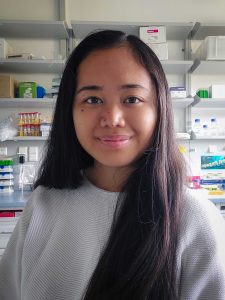Best poster prizes at ‘Proteomics in cell biology and disease mechanisms’
The EMBL–Wellcome Connecting Science Conference ‘Proteomics in cell biology and disease mechanisms‘ took place last month, bringing together experts to discuss the latest technological advances with a focus on medical and clinical applications of proteomics, as well as fundamental and mechanistic aspects of cell biology including intra- and inter-cellular communication through interactions and post-translational modifications.
This time, we had 179 people attending on site (and 70 virtually), including 8 fellowships provided by the EMBL Corporate Partnership Programme and EMBO. We held two poster sessions up on the helices of the Advanced Training Centre during which the presenters could discuss their research — their work was then voted for by the attendees and speakers. Five best poster prizes have been awarded during the meeting and we are pleased to share with you four of them!
1st prize: Detection of urinary proteome signatures and biomarkers in children with rare immunological diseases by dimethyl-based mDIA
Presenter: Ericka Itang

Max Planck Institute of Biochemistry, Germany
Abstract:
Urinary proteomics is an attractive approach in biomarker discovery because urine can be collected easily and non-invasively. As the by-product of plasma filtration in the kidney, urine contains information not only from the urinary tract but also from more distant organs, which is advantageous in identifying biomarkers of both urogenital and systemic diseases. However, urinary proteomic analysis is also challenging because the protein content of urine is highly variable across individuals. To enable this, we developed a dimethyl-based mDIA workflow (Thielert, Itang … Steger, Mann, 2023 Mol Syst Biol). By incorporating a reference channel, we increase reproducibility and quantification accuracy in the analysis of the urinary proteome. The “reference channel” is comprised of peptides pooled from all samples and is labeled with dimethyl 0, which is then multiplexed with the target channels in a 4:1:1 (0/4/8) ratio. Using our mDIA strategy along with MagReSyn® HILIC microspheres for urine sample preparation, a 30SPD gradient of the EvoSep One system coupled with the Bruker timsTOF HT platform for data acquisition, and DIA-NN 1.8.1 and our recently published RefQuant suite for downstream data processing, we hope to identify significant urinary markers in pediatric patients with various underlying diseases.
We first benchmarked the mDIA workflow on tryptic urinary peptides of healthy adults, resulting in about 2,200 protein group IDs in 100 ng of input material. We used the RefQuant algorithm, which takes advantage of the higher signal intensity in the reference channel, to accurately quantify and differentiate gender-related urinary proteins. The three-plex setup in mDIA, coupled with robot-aided automation of the sample preparation steps, increases the overall throughput and reproducibility. This urinary proteomics workflow is especially suited for the study of large cohorts in clinical proteomics. Here, we are in the process of measuring a cohort of 1000 pediatric patients and healthy controls from 3 to 18 years old with underlying immunological, gastroenterological, endocrinological, nephrological and other diseases with the aim of differentiating urinary proteomic signatures and biomarkers for pathological groups and specific diseases like Cystic Fibrosis, Celiac Disease, or Morbus Crohn.
A nanobody-based approach for capturing interactomes of specific dimeric protein complexes in live cells
Presenter: Nawal Hajj Sleiman

Abstract:
Many of the conditions grouped under the term “osteoporosis” correspond to a set of disorders affecting the balance between osteoclasts and osteoblasts and leading to a loss of bone tissue. Current treatments target osteoclasts and cause side effects that limit their long-term use. A promising alternative approach is to target osteoblasts to stimulate bone formation and thus promote osteogenesis. My project focuses on a major transcriptional regulator of osteogenesis, the TAZ factor, which acts as a downstream target of the Hippo signalling pathway. In the Hippo pathway, upstream kinases phosphorylate TAZ, inducing its interaction with the 14-3-3 protein and its sequestration in the cytoplasm. Dephosphorylation of TAZ promotes its migration to the nucleus where it interacts with various transcription factors, including TEAD2 factor to regulate the expression of specific target genes. Capturing the set of interactions (also called interactomes) that can be established by the TAZ/14-3-3 or TAZ/TEAD2 complexes may thus allow a better understanding of the molecular rules that control osteoblast differentiation. I was able to establish a new experimental approach, based on innovative tools, which allows to capture the interactions established by specific dimeric protein complexes. This tool is based on the TurboID proximity biotinylation system and a GFP nanobody to perform directed proximity biotinylation assay based on the Bimolecular Fluorescence Complementation (BiFC). The combination of these pioneer tools followed by LC-MS allowed us to capture the interactome of specific TAZ-Cofactor complexes, both in the cytoplasm and nucleus cellular compartment. This provided a unique understanding about the candidate cofactors implicated at each level of proliferation and differentiation of osteoblasts. My PhD work will identify new molecular players that can participate in the stimulation of osteogenesis and will serve as an unprecedented support for future therapeutic development against osteoporosis.
Due to the confidentiality of the unpublished data, we cannot share the poster.
A comprehensive comparison of methods for kinase activity inference
Presenter: Sophia Müller-Dott

Heidelberg University and Heidelberg University Hospital, Germany
Abstract:
Post translational modifications, such as protein phosphorylation, are critical in regulating cellular processes. Specifically, protein kinases, the key regulators of phosphorylation, play an important role in intracellular signal transduction by influencing protein activity, stability, localization, and interactions with other molecules. As such, protein kinases are one of the most targeted protein families for inhibition by small molecules. Accurately assessing kinase activity has emerged as an important factor for the identification of novel disease specific drug targets, development of patient specific therapeutics and prediction of treatment outcomes. In recent years, several methods have been developed to infer the activity of kinases from phosphoproteomic data. However, these methods usually rely on a fixed set of prior knowledge kinase substrate interactions and a systematic comparison and evaluation is still lacking.
In this study, we present a flexible framework to assess different combinations of methods and prior knowledge interaction for the inference of kinase activities. We implemented around 20 different methods in combination with several prior knowledge databases and compared the inferred kinase activities across methods using the CPTAC phosphoproteomics dataset of seven different cancer types. We evaluated the coverage of each prior knowledge database and investigated the influence of methodological approach versus prior knowledge on the inferred activities. Overall, the use of different prior knowledge databases resulted in more varied inferred activities than employing different methods. To gain deeper insights into the advantages and limitations of each method, we evaluated how well each combination was able to capture known targets of drug perturbation studies.
Altogether, our comprehensive approach allowed us to identify reliable prior knowledge databases and optimal methods for inferring kinase activity. Overall, this work contributes to a better understanding of kinase activity inference and offers valuable guidance for selecting appropriate methods and databases in kinase related research.
Ultra-deep proteome of osteosarcoma unravel non-genomic drivers for drug targeting
Presenter: Joris Frenz

Abstract:
Due to the confidentiality of the unpublished data, we cannot share the poster or the abstract.

Find out more about the #EWCSProteomics meeting from the blog post written by Daniela Castillo Perez, who participated as an event reporter!
The EMBL–Wellcome Connecting Science Conference ‘Proteomics in cell biology and disease mechanisms’ took place from 25 – 27 October 2023 at EMBL Heidelberg and virtually.